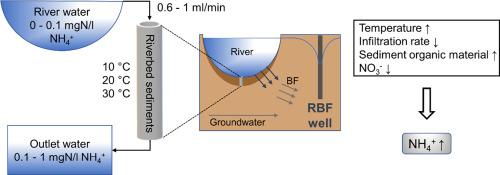Journal of Contaminant Hydrology ( IF 3.5 ) Pub Date : 2022-07-06 , DOI: 10.1016/j.jconhyd.2022.104050 Gustavo Covatti 1 , Thomas Grischek 1 , Diana Burghardt 2

|
Ammonium is an undesirable substance in the abstracted water of riverbank filtration (RBF) schemes, due mainly to the complications it causes during post-treatment (e. g. during chlorination). During RBF, ammonium can be formed in the riverbed by mineralization of organic nitrogen. Column experiments with riverbed sediments and river water from the Elbe were performed to evaluate the controls on ammonium concentrations during riverbed infiltration. Concentrations of ammonium went from <0.1 mgN/l in the feed water up to 1 mgN/l in the columns effluent. Higher temperatures and lower infiltration rates led to increased ammonium concentrations in the effluent. This shows higher susceptibility to ammonium increases of RBF settings in warmer climates and points to potential threats of climate change to water quality at RBF sites. In the later phases of the experiments, after the columns have been flushed their pore volumes several times, ammonium concentrations continually decreased. This behavior was attributed to the partial consumption of easily degradable organic material in the sediments, leading to lesser reducing conditions and lower mineralization rates. Based on operation with varied nitrate concentrations (0–11 mgN/l) and 15N isotopic measurements, dissimilatory nitrate reduction to ammonium (DNRA) was not shown to be relevant in the formation of ammonium. Anaerobic ammonium oxidation (anammox), however, was hypothesized to be an important sink of ammonium inside the columns, which indicates that rivers with high nitrate concentrations, such as the Elbe, may have a buffer of protection against ammonium formation during RBF.
中文翻译:

柱状实验追踪河岸过滤过程中铵的来源及转化
在河岸过滤 (RBF) 方案的抽取水中,铵是一种不受欢迎的物质,主要是由于它在后处理过程中(例如在氯化过程中)引起的并发症。在 RBF 过程中,有机氮矿化可在河床中形成铵。进行了河床沉积物和易北河河水的柱实验,以评估河床入渗过程中铵浓度的控制. 铵的浓度从进水中的 <0.1 mgN/l 上升到塔流出物中的 1 mgN/l。较高的温度和较低的渗透率导致流出物中的铵浓度增加。这表明在温暖的气候下 RBF 设置对铵增加的敏感性更高,并指出气候变化对 RBF 场地水质的潜在威胁。在实验的后期,在柱子的孔体积被冲洗了几次后,铵浓度不断下降。这种行为归因于沉积物中容易降解的有机物质的部分消耗,导致较少的还原条件和较低的矿化率。基于不同硝酸盐浓度 (0–11 mgN/l) 和15N 同位素测量、异化硝酸盐还原为铵 (DNRA) 与铵的形成无关。然而,厌氧氨氧化(anammox)被假设为柱内氨的重要汇,这表明硝酸盐浓度高的河流,如易北河,可能在 RBF 期间具有防止氨形成的缓冲。











































 京公网安备 11010802027423号
京公网安备 11010802027423号